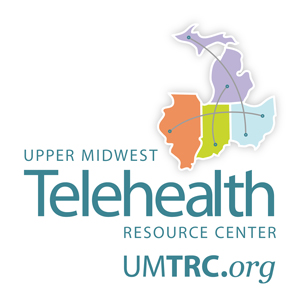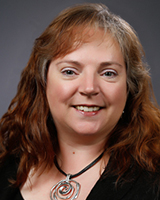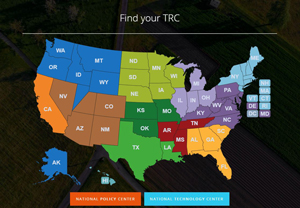May 29, 2019
Virtual Telehealth Librarians: A Closer Look at a Regional Telehealth Resource Center's Technical Assistance
With telehealth as an agenda item for over a decade, the Indiana Rural Health Association (IRHA) organization has received many grant awards. Through a current cooperative agreement with the Federal Office of Rural Health Policy's (FORHP) Office for the Advancement of Telehealth (OAT), IRHA has established the Upper Midwest Telehealth Resource Center (UMTRC), an organization that focuses on providing regional technical assistance to stakeholders in Illinois, Ohio, and Michigan, in addition to stakeholders in Indiana.
 Becky Sanders,
UMTRC's director of operations, spent her early career
working in the field of rural telecommunications. Moving
on to IRHA, one of her first projects involved laying
"miles and miles" of fiber optic
cables around Indiana. Inherent in that project was
building relationships with rural clinics and hospitals
and developing first-hand knowledge about what was needed
for those organizations to advance telehealth use. In her
current position, she shares her knowledge by serving the
stakeholder audience in UMTRC's 4-state region.
Becky Sanders,
UMTRC's director of operations, spent her early career
working in the field of rural telecommunications. Moving
on to IRHA, one of her first projects involved laying
"miles and miles" of fiber optic
cables around Indiana. Inherent in that project was
building relationships with rural clinics and hospitals
and developing first-hand knowledge about what was needed
for those organizations to advance telehealth use. In her
current position, she shares her knowledge by serving the
stakeholder audience in UMTRC's 4-state region.
"I refer to myself as a virtual telehealth librarian," Sanders said. "We connect stakeholders to the right telehealth information for their needs. Since we provide assistance to many different stakeholders in our region, we have to provide very tailored information by topic and by locale."
For example, the center provided assistance to an Indiana FORHP grantee, the Indiana Rural Schools Clinic Network (IRSCN). Kathleen Chelminiak, IRSCN project director, said UMTRC's assistance had a pivotal role in IRSCN's school-based telehealth project by helping the network understand broadband capacity, billing, and equipment.
"To start, UMTRC explored, with that 'insider's understanding,' what the true broadband needs of our project would be," Chelminiak said. "For example, asking schools not just about their basic broadband capacity, but what happens to bandwidth at noon when the students all start to use their mobile devices — that user demand might impact the ability of a clinic provider having a virtual school-based visit with a student. They answered questions related to billing and helped us understand reimbursement and related telehealth policy issues specific to Indiana. When it came to vetting telehealth equipment best suited for rural providers and schools, they were incredibly helpful."
In addition to assisting rural stakeholders like IRSCN, Sanders said the varied geography of their service area generates equally varied questions. The most common questions across the region are about reimbursement.
"We'll get calls from people exploring telehealth who ask 'How much do I get for doing X, Y, and Z?'" she said. "The answer always is, 'It depends.' Since state governments and commercial payers have different rules — as is the case for rural versus urban clinic and hospital reimbursement — the information must be specific."
Resource Needs: Flexible Technical Assistance

Since IRHA was awarded the UMTRC grant in 2011, Sanders said she's noted how resource needs have changed over the years as more and more of their region's healthcare systems and individual providers have adopted telehealth platforms.
"We travel often, attending major conferences, national, regional, or local rural meetings," she said. "When we return, we always have a 'to-do' list that usually takes us about 2 weeks to complete. But what's on that list now is different compared to 5 years ago. About 30% of our list includes assistance information requests that we can provide from the standardized resources we've created, somewhat of a 'short-order deliverable.' However, the other 70% of items on the list are from the more established programs. Because they are at a different stage of implementation and innovation, their questions are more advanced and sophisticated, taking longer to research in order to find the answers they need."
Sanders shared that FORHP grantees' needs are a priority — especially since those rural stakeholders are often working in organizations where project directors might have both clinical and non-clinical duties, in addition to simultaneous work on multiple projects.
"Since 2011, we have established relationships with many stakeholders," Sanders said. "We have personal knowledge of many of their needs and projects. Because our core customers are rural and wearing many hats with limits on the time they can devote to researching some aspect of telehealth, we can more efficiently meet their needs, especially those of FORHP grantees."
UMTRC's Expertise: Part of a Larger, National Telehealth Resource
According to Sanders, UMTRC's technical expertise is enriched by interactions with peers from the other 11 regional technical assistance centers across the country, all part of the National Consortium of Telehealth Resource Centers. Because telehealth services can involve companies and healthcare practitioners located in one state but providing services in other states, this collaborative approach is especially important.

"For example, a telehealth consultant located in Florida providing services in Ohio and Pennsylvania might pose a specific question," Sanders said. "The expertise to answer that question might require collaboration between our center and the Mid-Atlantic Telehealth Resource Center that serves Pennsylvania."
In addition to information exchange between regional centers, Sanders also shared how valuable the information exchange is with the 2 national resource centers: the National Telehealth Technology Assessment Resource Center located within the Alaska Native Tribal Health Consortium that provides "in-depth objective assessments for all types of telehealth technology" and the National Telehealth Policy Resource Center, a designated entity within the Center for Connected Health Policy located in California.
Sanders gave an example of how she relies on the policy center's work.
"Every 6 months, the policy center does a 50-state Medicaid policy scan and I'll review what they've written," she said. "Because of my regional connections, I might know something they're not aware of, for example, someone in my region that might be scheduled for a Congressional testimony. However, this information exchange also goes in reverse. They'll often have relationships at the national level that help us and from their comprehensive national scan, they're able to see national trends. While I may understand the impact of some policy in my 4 states, when I learn from them that the impact is not just on 4, but 20 states out of 50, that information can get more attention, even on a regional level."
The Future: More Telehealth Innovation
Sanders said she has loved being involved with telehealth these past 11 years. With that perspective she said she can also appreciate the current rapid change of not just telehealth technology itself, but the adoption of that technology.
"What telemedicine has done is to throw the healthcare industry on its head," she said. "The people now entering the workforce are digital customers. They see value in the immediacy that telehealth can offer. They're saying, 'Hey, why do I have to drive 45 minutes to sit there for 30 minutes when I can just videoconference a provider from my phone?' Run a query with the words telehealth, telemedicine, virtual, and mobile and I'll venture you'll find grants in magnitudes greater than previous years. It's likely to only increase. Why? Because it's more efficient, it's the way of the future, and rural patients will be expecting it."
National Telehealth Resources:
National Consortium of Telehealth Resource Centers
- Resource documents on topics ranging from "Telehealth Policy Issues" to "Funding Sources for Telehealth" to "15 Step Business Model."
National Telehealth Technology Assessment Resource Center
- Toolkits share technology fundamentals
- Media gallery of photos, videos, and other telehealth products
National Telehealth Policy Resource Center
Rural Health Information Hub resources:

